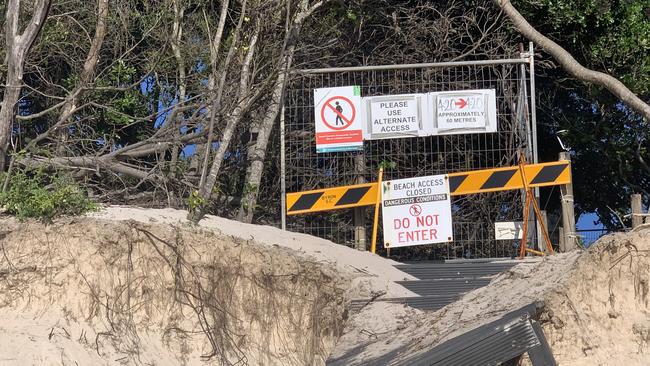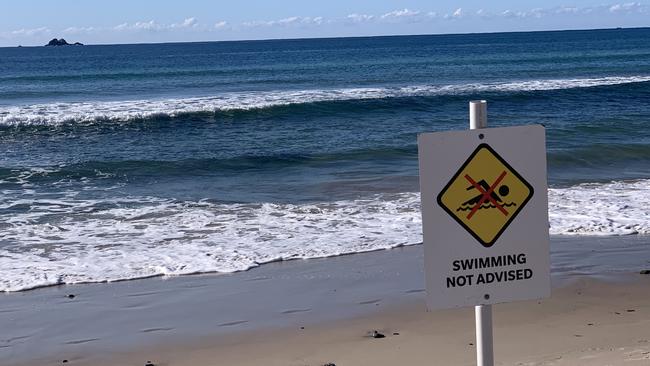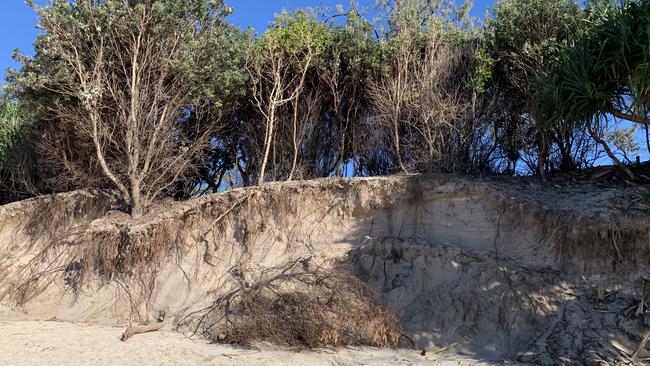Some of Byron’s famous beaches are still in a sad state months after they copped a battering
Coastal erosion continues to be a major problem on Byron Bay’s most famous beaches, but a new plan is in the works to enable “a more considered and scientific approach” to the issue.
Byron Shire
Don't miss out on the headlines from Byron Shire. Followed categories will be added to My News.
Residents and stakeholders of Byron Bay’s coastal strip will be holding out hope winter conditions will bring more sand back to the troubled beaches.
Byron Shire Council has meanwhile been continuing work on its new Coastal Management Plan, which mayor Michael Lyon said would likely be finalised by next year.
As the seemingly chronic erosion issue continues to trouble some of the shire’s most popular beaches, Mr Lyon said that document would be designed to offer “a much more considered and scientific approach which takes into account the necessary consultations with stakeholders”.
It won’t control Mother Nature but might help to equip those stakeholders for a better response, he said.
“We just haven’t been able to get to the finish line in the past,” Mr Lyon said.
“We are very confident, by some time next year, we will have a fully certified (plan).

“It doesn’t give you an ability to influence nature.
“It does give you a comprehensive and considered plan … which enables you to act (with) forward planning.”
Main Beach and Clarkes Beach have been experiencing this particular bout of severe erosion for about a year.
The coast copped a battering from wild weather in mid-2020 and has been a sad state since.
Signs have long been warning swimmers a dip at Main Beach would be ill-advised because of the many submerged rocks, exposed by the depleted sand.

The council’s staff have recently attributed the issue to a “a lack of consistent southerly swell” leading to “a lack of sand within the bay”.
In October last year, there were hopes a large “slug of sand” which had moved around The Pass would end up at the depleted beaches.
And people taking a stickybeak at the damage too close to the dunes has been a cause for concern at times while surf lifesavers have expressed concerns about the prominent closed beaches encouraging some to swim in unpatrolled, dangerous waters.
The council’s director of infrastructure services, Phil Holloway, said in April large swells hitting the coast had made the erosion worse again.
“There has been an incredible loss of sand on one of Australia’s signature beaches and it is really sad to see the incredible impact this has had on vegetation and beach amenity,” Mr Holloway said at the time.

“History tells us that the sand will eventually return but the dunes and vegetation may require assistance to rebuild and re-establish.”
He said this may take “many years”, depending on how soon sand returns to the beaches.
This has included concerning erosion on the dunes at the Reflections camping ground at Clarkes Beach and below the cafe there.
Mr Lyon said the situation along council-managed land was not yet at a stage that would trigger emergency action by the council.
The impacted areas are managed in part by the council, but parts fall under Crown Lands, Reflections management or the National Parks and Wildlife Service.
“Broadly, when assets are at risk – and we’re talking about physical assets, paths cabins roads surf clubs – when they’re at risk that’s when you’re likely to see some action,” Mr Lyon said.

“When our assets are at risk, then we will move into looking at what emergency measures we can put in place.
“But we aren’t there yet.
“I know it’s devastating, what’s happening on the beach.
“We are hoping and praying that we will soon enter an accretion phase, sand will be replaced and at that stage … we’ll be able to rebuild the dunal system (and) plant it out with more appropriate foliage or coverage.”
While much of the beach has been strewn with banksias, pandanus and other vegetation and Mr Lyon acknowledged it was “distressing to see them fall into the sea”, he said other types of plants would be more appropriate for this area.

He said sandbagging and sand nourishment had already happened at Manfred Street at Belongil Beach, and a similar approach would be an option at Main Beach if it gets to that same severe situation.
How far away that stretch of sand could be from requiring emergency action is unclear.
“You are certainly always a major weather event from that situation, potentially,” Mr Lyon said.
“Weather is an angry beast at times.
“If we continue to see this erosion then we will get to that point.”
Mr Lyon was hopeful the winter months could bring “the right type of swell” to contribute to sand accretion.




